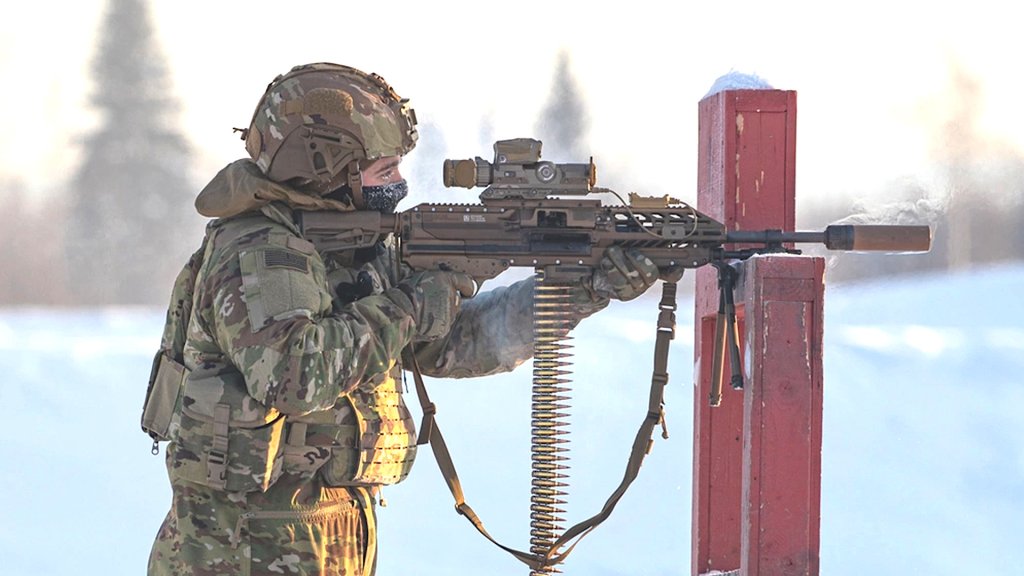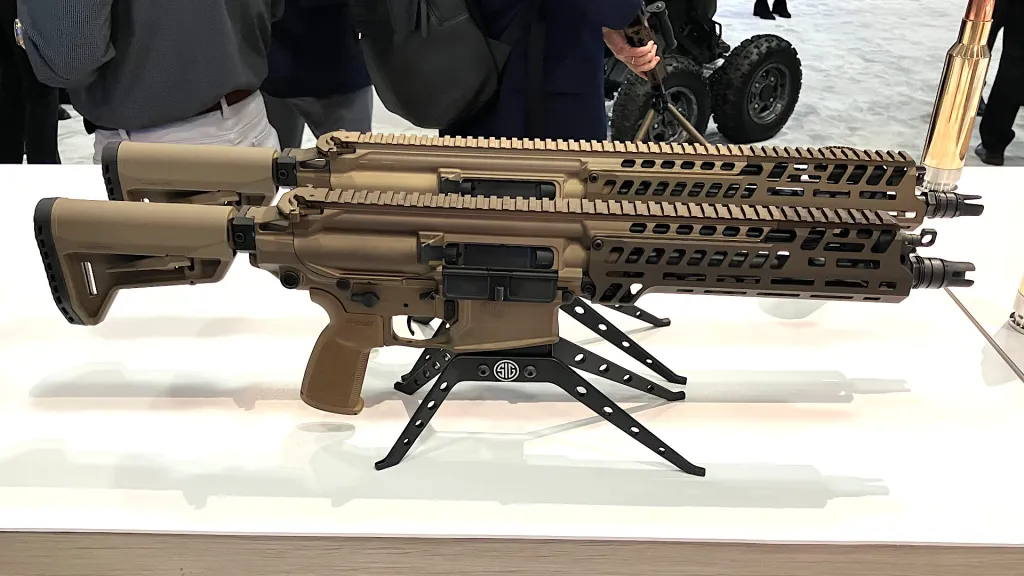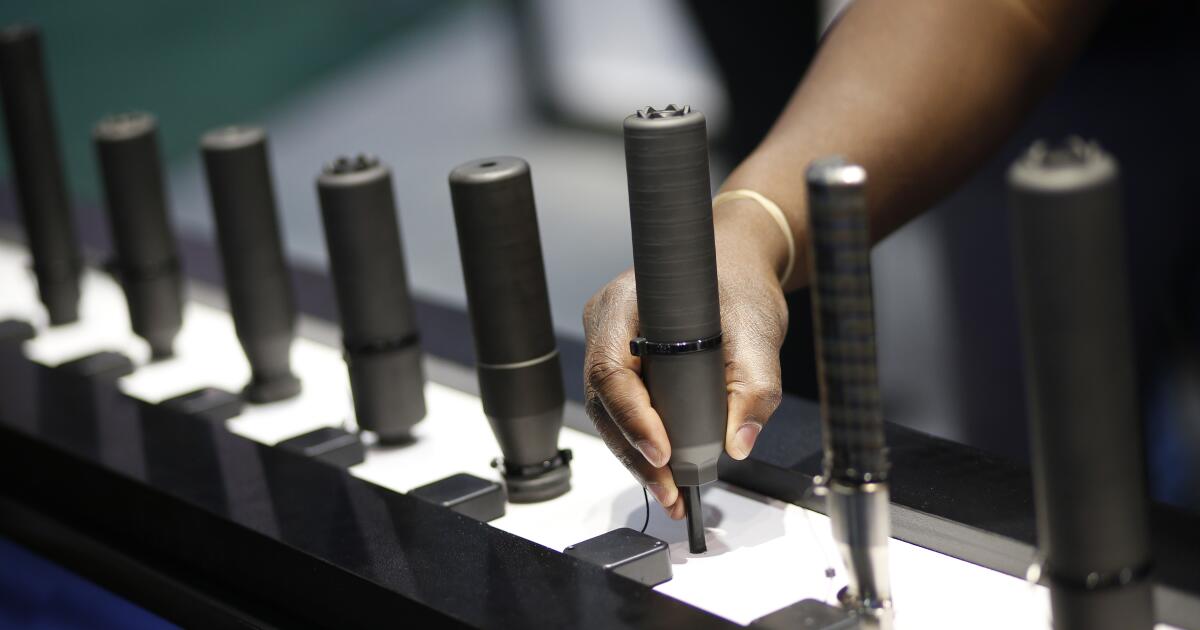Sig Sauer’s M7 Rifle For The Army Is Now Lighter After Controversy
Sig Sauer says it has been able to trim the weight of the Army’s new 6.8x51mm M7 service rifle by nearly a pound, or just over 10 percent, in response to feedback from servicemembers. The M7’s weight compared to the gun it is set to replace, the 5.56x45mm M4A1, was among the criticisms that an Army captain very publicly leveled against the gun earlier this year. Sig had subsequently issued a vehement rebuttal, but acknowledged that the design was still evolving.
Jason St. John, senior director of strategic products for the Defense Strategies Group at Sig Sauer, gave an update on the M7 rifle, as well as the companion 6.8x51mm M250 machine gun, to TWZ‘s Howard Altman on the show floor at the Association of the U.S. Army’s (AUSA) main annual symposium today. Sig Sauer has also been working on a shorter and lighter carbine variation of the M7 for the Army. Sig Sauer did show the lightened “product-improved” M7, also known as the PIE M7, at the biennial Defense and Security Equipment International (DSEI) exhibition in London earlier this year, but does not appear to have had the carbine on display at that event.

The M7 and M250 (previously designated the XM7 and XM250), together with the associated family of 6.8x51mm rounds and the computerized XM157 optic, form the Army’s Next Generation Squad Weapons (NGSW) ‘system.’ The service selected Sig Sauer as the winner of its NGSW competition in 2022 and now plans to replace a substantial portion of its M4A1s and M249 Squad Automatic Weapons (SAW) with M7s and M250s, respectively. Sig is also supplying the ammunition, but the XM157s are being procured separately from Vortex Optics.

“So, we’re talking about the Army’s and our continued teaming effort to improve the M7 and the M250, based on our recommendations, and their suggestions, and feedback from the field,” Sig Sauer’s St. John said.
“There’s basically two combined efforts going on within the M7,” he continued. “We have a carbine version, and then we have a lighten, improved version of the M7. And so when you look at the standard M7 that’s been issued to the troops, the overall weight of the firearm was 8.3 pounds. Now, the improved M7 is 7.6 pounds, and the carbine version weighs 7.3 pounds. So we’re getting closer and closer to [a] rifle weight system similar to the M4.”
The PIE M7 also has a 13.5-inch barrel, while the one on the carbine version is 10 inches long. A standard M4A1 with its 14.5-inch barrel, as well as just a sling and a loaded magazine, weighs in at 7.62 pounds, according to the Army. It is important to note that optics and other accessories add appreciable weight to both the M7 and M4A1. The XM157 optic is notably larger and heavier than the ones the Army typically issues for use on M4A1s.


In terms of how the PIE M7 was lightened, “there’s the upper receiver, we’ve redesigned and taken some weight out of it. We’ve lessened the barrel profile slightly to get some weight out of it,” according to Sig’s St. John. “We’ve done some lightening efforts within the operating system, as well as remove the folding stock hinge. By removing that hinge, we save some weight.”
The original M7 featured a stock that was both adjustable in length and could be folded to one side. The M4A1’s stock is only adjustable in length.
“What we just found is really that the Army and the soldiers have fed back … [that] they’d rather have the weight savings than the folding stock,” St. John added. “They aren’t using the folding stock enough to justify that additional weight.”
The video in the Tweet below shows a placard with additional details about the PIE M7 and the carbine version at around 0:41 in the runtime.

Sig Sauer has also made important changes to the M250’s design based on discussions with the Army and feedback from soldiers.
“You’re going to see, instead of having a removable front handguard, now you have a hinged captured handguard, so it stays on the weapon system – rotates forward and away,” St. John explained. “The feed tray cover is extended with the big rail, so that now I have more adjustability for the optics that I put on there, and eye relief to the individual soldiers, and now I can move my optic further back or forward depending on what’s wanted.”
“I’ve got improved bipods. I’ve got [an] improved gas valve,” he continued, also highlighting improvements to how the M250 can be fitted to a tripod and how ammunition is carried on the gun. “Basically the feedback from everyone is, what can we do to improve this weapon system, make it more easy [sic] to use, and more robust and reliable.”

Work has also been done to improve the common sound suppressor for the M7 and M250.
“We’ve also redesigned our suppressor to make it shorter,” per St. John. “We’ve added a titanium heat shield on it that does two-fold [things].”
The heat shield helps reduce the chance of contact burns as the suppressor heats up during use. It also reduces thermal bloom, which could make it easier for enemies to spot friendly forces from their heat signature. St. John cautioned that no one should be rushing to grab the suppressor, especially with bare hands, after sustained use, even with the new heat shield.
When it comes to the M7, St. John said that the Army is now in the process of deciding how to proceed in fielding the PIE and/or carbine versions.
“You could see there’s probably a couple of decision points. Do they stick with the standard length M7 that’s been lightened by 0.7 pounds? Or do they and or do they move to the carbine completely?” he said. “Do they keep the carbine for specialty troops and still issue the M7, or do they take the carbine and utilize that as the new rifle across the board? So they’re trying to make those decisions.”

St. John pointed out that the Army had gone through a similar evolution in thinking in the decades that followed the fielding of the A1 variant of the M16 in the 1960s. The service adopted a succession of full-size rifle versions before transitioning to the shorter and lighter M4A1 as its standard service weapon.
That the Army is looking at lighter variations of the M7 at all is significant. The weight of the rifle was among the criticisms that Army Capt. Braden Trent had highlighted in an unclassified report he wrote while he was a student at the Expeditionary Warfare School, which is part of the Marine Corps University in Quantico, Virginia. Trent also called attention to the comparative size and weight of the 5.56x45mm and 6.8x51mm rounds, as well as the shorter barrel on the M7 compared to the M4A1. Trent’s findings, which raised safety concerns about the rifle and cited other issues that called its operational utility into question, came to more widespread attention after he presented them at the annual Modern Day Marine conference earlier this year.
There is one particular “major fault in the XM7, and that’s the UBL … or universal basic load. It’s a metric that can be applied to almost any weapon system, and it essentially means the amount of magazines and associated ammunition that a system uses and is expected to be carried into battle,” Trent said at Modern Day Marine. “So the XM7 [and] the M4A1 actually have the same number of magazines in their UBL seven, but remember, we’re talking about that capacity difference. The total round count a soldier carries into battle with the XM7 is 140 rounds compared to the 210 rounds of the M4A1. Now again, a 70-round difference may not seem significant, but to the soldier in the fight, it absolutely is a difference. Not to mention that every magazine added to the XM7, each 20-round loaded magazine adds another 1.25 pounds to the soldier’s load, meaning that if troops equipped with the XM7 tried to match their old UBLs [in terms of round count], they’re going to have even more weight being carried.”
“The final thing I’d like to mention is the Chief of Army Infantry’s stated goal of a 55-pound total soldier load,” he added. “If we just take the XM7 and its seven UBL magazine load, we’re almost at half that weight, and that’s before the soldier is put on body armor, water, a rucksack, or anything else that they’ll need in the fight.”

The Army’s position has been that the M7 and its new cartridge offer improved accuracy, range, and terminal effectiveness that are worth the added bulk. Concerns about soldiers being outranged, as well as improvements in adversary body armor, were key drivers behind the NGSW program. Trent’s report also calls this into question based on data he collected regarding expected infantry combat engagement distances.
Sig Sauer had also provided a lengthy rebuttal to the technical issues that Trent raised. You can read more about all of this in TWZ‘s in-depth report on the ensuing controversy following his presentation.
“I think that soldiers and citizens should want Sig Sauer, the U.S. [Army] program office to continue that practice of continually evolving and developing and improving their soldiers’ weapons systems. And I think we anticipate that we’re going to undergo those improvement processes for the next 25 to 30 years,” the company’s St. John had told TWZ at the time. “There’s going to be improvements in manufacturing [and] materials processes. The soldiers on the ground and the U.S. Army are going to dictate different operational requirements and standards for the weapons systems, and we’re going to have to react to those modifications that are going to optimize that weapon system as that evolves through time and history.”
“It should be no surprise, in my opinion, that specifically in the infancy of a weapons program that there’s a very aggressive improvement effort to ensure that the Army and the soldiers get the weapon system that they deserve,” he added.
From what we know now, the Army’s plans for the M7 are already evolving significantly, with criticisms about the rifle’s weight, in particular, having been taken to heart.
Howard Altman contributed to this story.
Contact the author: [email protected]












